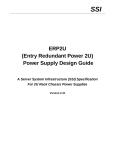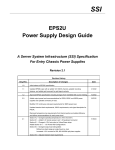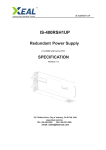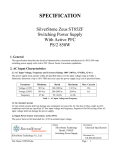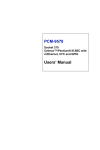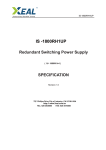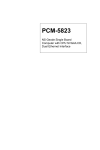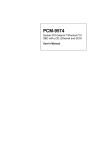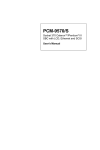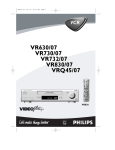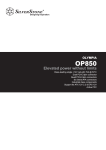Download Intel 2U User's Manual
Transcript
SSI
ERP2U
(Entry Redundant Power 2U)
Power Supply Design Guide
A Server System Infrastructure (SSI) Specification
For 2U Rack Chassis Power Supplies
Version 1.0
SSI
ERP2U Power Supply Design Guide, V1.0
Disclaimer:
THIS SPECIFICATION IS PROVIDED "AS IS" WITH NO WARRANTIES
WHATSOEVER,
INCLUDING
ANY
WARRANTY
OF
MERCHANTABILITY,
NONINFRINGEMENT, FITNESS FOR ANY PARTICULAR PURPOSE, OR ANY
WARRANTY OTHERWISE ARISING OUT OF ANY PROPOSAL, SPECIFICATION OR
SAMPLE.
WITHOUT LIMITATION, THE PROMOTERS (Intel Corporation, NEC
Corporation, Dell Computer Corporation, Data General a division of EMC Corporation,
Compaq Computer Corporation, Silicon Graphics Inc., and International Business
Machines Corporation) DISCLAIM ALL LIABILITY FOR COST OF PROCUREMENT OF
SUBSTITUTE GOODS OR SERVICES, LOST PROFITS, LOSS OF USE, LOSS OF
DATA OR ANY INCIDENTAL, CONSEQUENTIAL, DIRECT, INDIRECT, OR SPECIAL
AMAGES, WHETHER UNDER CONTRACT, TORT, WARRANTY OR OTHERWISE,
ARISING IN ANY WAY OUT OF USE OR RELIANCE UPON THIS SPECIFICATION OR
ANY INFORMATION HEREIN.
The Promoters disclaim all liability, including liability for infringement of any proprietary
rights, relating to use of information in this specification. No license, express or implied,
by estoppel or otherwise, to any intellectual property rights is granted herein.
This specification and the information herein is the confidential and trade secret
information of the Promoters. Use, reproduction and disclosure of this specification and
the information herein is subject to the terms of the S.S.I. Specification Adopter's
Agreement.
Copyright Intel Corporation, Dell Computer Corporation, Compaq Computer Corporation, Silicon Graphics
Inc., International Business Machines Corporation, 2000.
-2-
SSI
ERP2U Power Supply Design Guide, V1.0
Contents
1
Purpose ..............................................................................................................................................5
2
Conceptual Overview..........................................................................................................................5
3
Definitions/Terms/Acronyms..............................................................................................................6
4
Mechanical Overview..........................................................................................................................7
4.1
Recommended Chassis Mounting Method ..........................................................................................8
4.2
Airflow Requirements.........................................................................................................................8
4.2.1
Redundant Cooling .....................................................................................................................9
4.3
Temperature Requirements................................................................................................................9
5
AC Input Requirements.......................................................................................................................9
AC Inlet Connector ............................................................................................................................9
Redundant AC Inlets..........................................................................................................................9
AC Input Voltage Specification ......................................................................................................... 10
Efficiency ........................................................................................................................................ 10
AC Line Dropout .............................................................................................................................. 11
AC Line Fuse .................................................................................................................................. 11
AC Inrush........................................................................................................................................ 11
AC Line Transient Specification ........................................................................................................ 12
AC Line Fast Transient Specification ................................................................................................ 12
5.1
5.2
5.3
5.4
5.5
5.6
5.7
5.8
5.9
6
DC Output Specification ................................................................................................................... 13
6.1
Output Connectors .......................................................................................................................... 13
6.1.1
Required Baseboard power connector ....................................................................................... 13
6.1.2
Optional Processor Power Connector......................................................................................... 13
6.1.3
Required Peripheral Power Connectors ...................................................................................... 14
6.1.4
Required Floppy Power Connector ............................................................................................ 14
6.1.5
Optional Server Signal Connector.............................................................................................. 15
6.2
Grounding ....................................................................................................................................... 15
6.3
Remote Sense ................................................................................................................................ 15
6.4
Output Power/Currents .................................................................................................................... 16
6.4.1
Standby Outputs....................................................................................................................... 17
6.5
Voltage Regulation .......................................................................................................................... 17
6.6
Dynamic Loading............................................................................................................................. 18
6.7
Capacitive Loading .......................................................................................................................... 18
6.8
Ripple / Noise.................................................................................................................................. 18
6.9
Redundancy.................................................................................................................................... 19
6.10
Hot Swap Requirements............................................................................................................... 19
6.11
Timing Requirements ................................................................................................................... 21
7
Protection Circuits............................................................................................................................ 24
Current Limit ................................................................................................................................... 24
240VA Protection ............................................................................................................................ 24
Over Voltage Protection................................................................................................................... 25
Over Temperature Protection ........................................................................................................... 25
7.1
7.2
7.3
7.4
8
Control and Indicator Functions....................................................................................................... 26
8.1
PSON# ........................................................................................................................................... 26
-3-
SSI
ERP2U Power Supply Design Guide, V1.0
8.2
PWOK (Power OK).......................................................................................................................... 27
8.3
SMBus Communication.................................................................................................................... 28
8.3.1
Field Replacement Unit (FRU) Signals ....................................................................................... 28
8.3.2
Module FRU Data..................................................................................................................... 28
8.3.3
Module FRU Data Format ......................................................................................................... 28
8.4
LED Indicators................................................................................................................................. 30
9
MTBF ................................................................................................................................................ 31
10
Agency Requirements ...................................................................................................................... 31
Figures
Figure 1:
Figure 2:
Figure 3:
Figure 4:
Enclosure Drawing...........................................................................................................................7
Output Voltage Timing ................................................................................................................... 21
Turn On/Off Timing ........................................................................................................................ 23
PSON# Signal Characteristics ........................................................................................................ 26
Tables
Table 1: Thermal Requirements......................................................................................................................9
Table 2: AC Input Rating .............................................................................................................................. 10
Table 3: Efficiency ....................................................................................................................................... 10
Table 4: AC Line Sag Transient Performance ................................................................................................ 12
Table 5: AC Line Surge Transient Performance ............................................................................................. 12
Table 6: P1 Baseboard Power Connector ...................................................................................................... 13
Table 7: Processor Power Connector ............................................................................................................ 13
Table 8: Peripheral Power Connectors .......................................................................................................... 14
Table 9: P9 Floppy Power Connector ............................................................................................................ 14
Table 10: Server Signal Connector................................................................................................................ 15
Table 11: 350 W Load Ratings ...................................................................................................................... 16
Table 12: 480 W Load Ratings ...................................................................................................................... 16
Table 13: Voltage Regulation Limits .............................................................................................................. 17
Table 14: Optional +5V Regulation Limits ...................................................................................................... 17
Table 15: Transient Load Requirements ........................................................................................................ 18
Table 16: Capacitve Loading Conditions........................................................................................................ 18
Table 17: Ripple and Noise .......................................................................................................................... 19
Table 18: Output Voltage Timing................................................................................................................... 21
Table 19: Turn On/Off Timing ....................................................................................................................... 22
Table 20: Over Current Protection................................................................................................................. 24
Table 21: Over Current Protection................................................................................................................. 25
Table 22: Over Voltage Limits....................................................................................................................... 25
#
Table 23: PSON Signal Characteristic.......................................................................................................... 26
Table 24: PWOK Signal Characteristics ........................................................................................................ 27
Table 25: FRU Device Information ................................................................................................................ 28
Table 26: FRU Device Product Information Area ............................................................................................ 28
Table 27: FRU Device Product Information Area ............................................................................................ 29
Table 28: LED Indicators .............................................................................................................................. 30
-4-
SSI
ERP2U Power Supply Design Guide, V1.0
1 Purpose
This 2U Rack Power Supply Design Guide defines a common redundant power sub-system used in 2U rack
mount servers. The power sub-system is made up of a cage and hot swap redundant power modules. This
Design Guide covers the mechanical and electrical requirements of this power sub-system. The requirements of
the individual hot swap modules are left open. This power sub-system may range from 350 to 600 watts and is
used in a hot swap redundant configuration. The scope of this document defines the requirements for this power
assembly. The parameters of this supply are defined in this design guide for open industry use.
2 Conceptual Overview
In the Entry server market, the bulk power system must source power on several output rails.
These rails are typically as follows:
•
+3.3 V (optional from bulk supply)
•
+5 V (optional from bulk supply)
•
+12 V
•
–12 V
•
5 V standby
NOTE
Local DC-DC converters shall be utilized for processor power, and will ideally convert power from the +12 V
rail, however, they may also convert power from other rails.
The bulk power system may be a n+1 redundant power system or a non-redundant power system.
-5-
SSI
ERP2U Power Supply Design Guide, V1.0
3 Definitions/Terms/Acronyms
Required
The status given to items within this design guide, which are required to
meet SSI guidelines and a large majority of system applications.
Recommended
The status given to items within this design guide which are not required to
meet SSI guidelines, however, are required by many system applications.
Optional
The status given to items within this design guide, which are not required to
meet SSI guidelines, however, some system applications may optionally
use these features.
Autoranging
A power supply that automatically senses and adjusts itself to the proper
input voltage range (110 VAC or 220 VAC). No manual switches or
manual adjustments are needed.
CFM
Cubic Feet per Minute (airflow).
Dropout
A condition that allows the line voltage input to the power supply to drop to
below the minimum operating voltage.
Latch Off
A power supply, after detecting a fault condition, shuts itself off. Even if the
fault condition disappears, the supply does not restart unless manual or
electronic intervention occurs. Manual intervention commonly includes
briefly removing and then reconnecting the supply, or it could be done
through a switch. Electronic intervention could be done by electronic
signals in the Server System.
Monotonically
A waveform changes from one level to another in a steady fashion, without
intermediate retracement or oscillation.
Noise
The periodic or random signals over frequency band of 0 Hz to 20 MHz.
Overcurrent
A condition in which a supply attempts to provide more output current than
the amount for which it is rated. This commonly occurs if there is a "short
circuit" condition in the load attached to the supply.
PFC
Power Factor Corrected.
Ripple
The periodic or random signals over a frequency band of 0 Hz to 20 MHz.
Rise Time
Rise time is defined as the time it takes any output voltage to rise from
10% to 95% of its nominal voltage.
Sag
The condition where the AC line voltage drops below the nominal voltage
conditions.
Surge
The condition where the AC line voltage rises above nominal voltage.
VSB or Standby Voltage
An output voltage that is present whenever AC power is applied to the AC
inputs of the supply.
MTBF
Mean time between failure.
PWOK
A typical logic level output signal provided by the supply that signals the
Server System that all DC output voltages are within their specified range.
-6-
SSI
ERP2U Power Supply Design Guide, V1.0
4 Mechanical Overview
STATUS
Required (Optional)
Note: Some features are noted as optional in the enclosure drawing figure below. These features may be use in
some chassis designs where only top access is allowed for the cage mounting.
The ERP2U is a power sub-system made up of a cage and redundant, hot swappable power supply modules. A
mechanical drawing of the cage is shown below in Figure 1. This cage is intended to be mounted in the system
and not redundant or hot swappable. The exterior face of the cage accepts hot swappable power supply
modules. The cage distributes output power from the modules to a wire harness. Cooling fans may be located in
the modules or cage. If the cooling fans are located in the cage, they may optionally be redundant. If the cage
has redundant cooling the cage depth may be extended to allow for the additional series fan. A recommended
power supply module solution is the SSI TPS power supply. Refer to www.ssiforum.org for the latest TPS Design
Guide. The cage may have IEC inlet connector(s) and EMI filtering to distribute AC power to the power supply
modules or the AC may plug directly into the modules. Three different configurations of the power sub-system
are also shown below in Figure 1.
Optional mounting features for top access
mounting of the power supply.
Power Module
Allow for 1.2mm
Configuration Options
protrusion (x4)
AC
AC
Module Module
AC
AC
Module
Module
AC
Module
AC
Module
Figure 1: Enclosure Drawing
-7-
SSI TPS Power Supply Configuration
No Fans in modules
AC inlets and EMI filter in cage
Optional Dual AC Inlets
Optional 3.3V, 5V DC/DC converters in cage
Vertical Power Supply Configuration
Fans in modules
AC inlets on modules
Dual AC Inlets
Optional 3.3V, 5V DC/DC converters in cage
Horizontal Power Supply Configuration
Fans in modules
AC inlets on modules
Dual AC Inlets
Optional 3.3V, 5V DC/DC converters in cage
SSI
ERP2U Power Supply Design Guide, V1.0
4.1
Optional Chassis Mounting Features
STATUS
Optional
The optional top access mounting method fastens to the system chassis via three mounting holes; two on the
exterior face and one with the tab on the interior face of the cage. There are also four rectangular cutouts on the
bottom of the cage. These are intended to drop over the top of rectangular features in the bottom of the chassis.
This will help position the cage and secure it laterally. The features in the chassis are shown below as a
reference.
.
4.2
Airflow Requirements
STATUS
Recommended
The power supply cooling, whether in the cage or the module, shall have a two-speed fan(s) and provide cooling
to both the supply and the system. During low-speed fan operation, the power supply must not exceed a noise
level of 43 dBa measured at one meter on all faces. At low fan speed, the power supply shall provide a minimum
of 6 CFM. At high fan speed, the power supply shall provide a minimum of 9 CFM.
-8-
SSI
ERP2U Power Supply Design Guide, V1.0
4.2.1
Redundant Cooling
STATUS
Recommended
It is recommended that the power supply cooling be redundant. This means the cooling device is located in the
hot swap power supply modules or there are redundant devices located on the cage.
4.3
Temperature Requirements
STATUS
Recommended
The power supply shall operate within all specified limits over the Top temperature range. All airflow shall pass
through the power supply and not over the exterior surfaces of the power supply.
Table 1: Thermal Requirements
ITEM
DESCRIPTION
Top
Operating temperature range.
Tnon-op
Non-operating temperature range.
MIN
MAX
UNITS
0
50
°C
-40
70
°C
The power supply must meet UL enclosure requirements for temperature rise limits. All sides of the power supply
with exception to the air exhaust side, must be classified as “Handle, knobs, grips, etc. held for short periods of
time only”.
5 AC Input Requirements
STATUS
Required
The power supply modules shall incorporate universal power input with active power factor correction, which shall
reduce line harmonics in accordance with the EN61000-3-2 and JEIDA MITI standards.
5.1
AC Inlet Connector
STATUS
Required
The AC input connector shall be an IEC 320 C-14 power inlet. This inlet is rated for 15 A/250 VAC. This
connector may be located on the module or on the cage.
5.2
Redundant AC Inlets
STATUS
Recommended
The power supply assembly may have dual redundant AC inlets. The power supply shall be able to operate over
its full, specified range of requirements with either or both AC input powered. If there is a loss of one AC inlet the
-9-
SSI
ERP2U Power Supply Design Guide, V1.0
power supplies shall continue to operate with no interruption of performance. It is required that all redundant
power supply modules be present to support redundant AC inlets.
5.3
AC Input Voltage Specification
STATUS
Required
The power supply must operate within all specified limits over the following input voltage range. Harmonic
distortion of up to 10% THD must not cause the power supply to go out of specified limits. The power supply shall
operate properly at 85 VAC input voltage to guarantee proper design margins.
Table 2: AC Input Rating
1
5.4
PARAMETER
MIN
RATED
MAX
350W Max
Rated Input
Current
480W Max
Rated Input
Current
Voltage (110)
90 V rms
100-127
V rms
140 V rms
5.5 A rms 1
7.0 A rms 1
Voltage (220)
180 V rms
200-240
V rms
264 V rms
2.3 A rms 1
3.5 A rms 1
Frequency
47 Hz
63 Hz
Maximum rated input current is measured at 100 VAC and 200 VAC.
Efficiency
STATUS
Required
The power supply shall have a minimum efficiency shown in the table below for the different power ratings. The
power dissipated within the sub-system shall be kept to less than 150W. The sub-system shall meet the minimum
efficiency at 100VAC and maximum output load.
Table 3: Efficiency
Output
Power
Minimum
Efficiency
350W
70%
480W
77%
- 10 -
SSI
ERP2U Power Supply Design Guide, V1.0
5.5
AC Line Dropout
STATUS
Required
An AC line dropout is defined to be when the AC input drops to 0 VAC at any phase of the AC line for any length
of time. During an AC dropout of one cycle or less the power supply must meet dynamic voltage regulation
requirements over the rated load. An AC line dropout of one cycle or less shall not cause any tripping of control
signals or protection circuits. If the AC dropout lasts longer than one cycle, the power supply should recover and
meet all turn on requirements. The power supply must meet the AC dropout requirement over rated AC voltages,
frequencies, and output loading conditions. Any dropout of the AC line shall not cause damage to the power
supply. In the case of redundant AC inputs, the AC line dropout may occur on either or both AC inlet.
5.6
AC Line Fuse
STATUS
Required
The power supply shall incorporate one input fuse on the LINE side for input over-current protection to prevent
damage to the power supply and meet product safety requirements. Fuses should be slow blow type or
equivalent to prevent nuisance trips. AC inrush current shall not cause the AC line fuse to blow under any
conditions. All protection circuits in the power supply shall not cause the AC fuse to blow unless a component in
the power supply has failed. This includes DC output load short conditions.
5.7
AC Inrush
STATUS
Required
The power supply must meet inrush requirements for any rated AC voltage, during turn on at any phase of AC
voltage, during a single cycle AC dropout condition, during repetitive ON/OFF cycling of AC, and over the
specified temperature range (Top). The peak inrush current shall be less than the ratings of its critical components
(including input fuse, bulk rectifiers, and surge limiting device).
STATUS
Recommended
An additional inrush current limit is recommended for some system applications that require multiple systems on a
single AC circuit. AC line inrush current shall not exceed 40 A peak. After one-quarter of the AC cycle, the input
current should be no more than the specified maximum input current from Table 2.
- 11 -
SSI
ERP2U Power Supply Design Guide, V1.0
5.8
AC Line Transient Specification
STATUS
Recommended
AC line transient conditions shall be defined as “sag” and “surge” conditions. Sag conditions (also referred to as
“brownout” conditions) will be defined as the AC line voltage dropping below nominal voltage. Surge conditions
will be defined as the AC line voltage rising above nominal voltage.
The power supply shall meet the requirements under the following AC line sag and surge conditions.
Table 4: AC Line Sag Transient Performance
AC Line Sag
Duration
Sag
Operating AC Voltage
Line Frequency
Performance Criteria
Continuous
10%
Nominal AC Voltage ranges
50/60 Hz
No loss of function or performance
0 to 1 AC
cycle
100%
Nominal AC Voltage ranges
50/60 Hz
No loss of function or performance
>1 AC cycle
>10%
Nominal AC Voltage ranges
50/60 Hz
Loss of function acceptable, self
recoverable
Table 5: AC Line Surge Transient Performance
AC Line Surge
Duration
Surge
Operating AC Voltage
Line Frequency
Performance Criteria
Continuous
10%
Nominal AC Voltages
50/60 Hz
No loss of function or performance
0 to ½ AC
cycle
30%
Mid-point of nominal AC
Voltages
50/60 Hz
No loss of function or performance
5.9
AC Line Fast Transient Specification
STATUS
Recommended
The power supply shall meet the EN61000-4-5 directive and any additional requirements in IEC1000-4-5:1995
and the Level 3 requirements for surge-withstand capability, with the following conditions and exceptions:
•
These input transients must not cause any out-of-regulation conditions, such as overshoot and
undershoot, nor must it cause any nuisance trips of any of the power supply protection circuits.
•
The surge-withstand test must not produce damage to the power supply.
•
The supply must meet surge-withstand test conditions under maximum and minimum DC-output load
conditions.
- 12 -
SSI
ERP2U Power Supply Design Guide, V1.0
6 DC Output Specification
These are the output requirements for the power supply assembly including cage and module.
6.1
Output Connectors
The power supply assembly shall have the following output connectors and wire harness configuration.
6.1.1
Required Baseboard power connector
Connector housing: 24-Pin Molex 39-01-2240 or equivalent
Contact: Molex 44476-1111 or equivalent
Table 6: P1 Baseboard Power Connector
6.1.2
Pin
Signal
18 AWG Color
Pin
Signal
18 AWG Color
1
+3.3 VDC
Orange
13
+3.3 VDC
Orange
2
+3.3 VDC
Orange
14
-12 VDC
Blue
3
COM
Black
15
COM
Black
4
+5 VDC
Red
16
PS_ON
Green
5
COM
Black
17
COM
Black
6
+5 VDC
Red
18
COM
Black
7
COM
Black
19
COM
Black
8
PWR OK
Gray
20
Reserved (-5 V in
ATX)
N.C.
9
5 VSB
Purple
21
+5 VDC
Red
10
+12 V2
Yellow/Blue Stripe
22
+5 VDC
Red
11
+12 V2
Yellow/Blue Stripe
23
+5 VDC
Red
12
+3.3 VDC
Orange
24
COM
Black
Optional Processor Power Connector
This connector is needed for systems with dual processors at higher power levels.
Connector housing: 8-Pin Molex 39-01-2080 or equivalent
Contact: Molex 44476-1111 or equivalent
Table 7: Processor Power Connector
Pin
Signal
18 AWG color
Pin
Signal
18 AWG Color
1
COM
Black
5
+12 V1
Yellow/Black Stripe
2
COM
Black
6
+12 V1
Yellow/Black Stripe
3
COM
Black
7
+12 V1
Yellow/Black Stripe
4
COM
Black
8
+12 V1
Yellow/Black Stripe
- 13 -
SSI
ERP2U Power Supply Design Guide, V1.0
6.1.3
Required Peripheral Power Connectors
Connector housing: Amp 1-480424-0 or equivalent
Contact: Amp 61314-1 contact or equivalent
Table 8: Peripheral Power Connectors
Pin
Signal
18 AWG Color
1
+12V2 (or +12V3)
Yellow
2
COM
Black
3
COM
Black
4
+5 VDC
Red
Note: The +12V power to peripherals may be split between 2 or 3 channel for the purpose of
limiting power to less than 240VA.
6.1.4
Required Floppy Power Connector
Connector housing: Amp 171822-4 or equivalent
Table 9: P9 Floppy Power Connector
Pin
Signal
22 AWG Color
1
+5 VDC
Red
2
COM
Black
3
COM
Black
4
+12 V2 (or +12V3)
Yellow
Note: The +12V power to peripherals may be split between 2 or 3 channel for the purpose of
limiting power to less than 240VA.
- 14 -
SSI
ERP2U Power Supply Design Guide, V1.0
6.1.5
Optional Server Signal Connector
Connector housing: 5-pin Molex 50-57-9405 or equivalent
Contacts: Molex 16-02-0088 or equivalent (gold plated)
Notes:
It is recommended to use gold plated signal contacts on both the power supply connector and the baseboard
header.
If the optional server signal connector is not used on the power supply the 3.3VRS and ReturnS lines shall be
crimped into the contacts in the baseboard power connector.
If the server signal connector is unplugged, the power supply shall not shutdown or go into an over voltage
condition.
Table 10: Server Signal Connector
Pin
6.2
Signal
24 AWG Color
1
I2C Clock
White/Green Stripe
2
I2C Data
White/Yellow Stripe
3
Reserved
NA
4
ReturnS
Black/White Stripe
5
3.3RS
Orange/White Stripe
Grounding
STATUS
Required
The ground of the pins of the power assembly wire harness provides the power return path. The wire harness
ground pins shall be connected to safety ground (power supply enclosure).
6.3
Remote Sense
STATUS
Optional
The power assembly may have remote sense for the +3.3V (3.3VS) and return (ReturnS) if the Optional Server
Signal connector is implemented and the module has a +3.3V output. The remote sense return (ReturnS) is used
to regulate out ground drops for all output voltages. The +3.3V remote sense (3.3VS) is used to regulate out
drops in the system for the +3.3 V output. The remote sense input impedance to the power sub-assembly must
be greater than 200 ohms on 3.3 VS and ReturnS. This is the value of the resistor connecting the remote sense
to the output voltage internal to the power assembly. Remote sense must be able to regulate out a minimum of
200 mV drop on the +3.3 V output. The remote sense return (ReturnS) must be able to regulate out a minimum of
200 mV drop in the power ground return. The current in any remote sense line shall be less than 5 mA to prevent
voltage sensing errors. The power supply must operate within specification over the full range of voltage drops
from the power assembly’s output connector to the remote sense points.
- 15 -
SSI
ERP2U Power Supply Design Guide, V1.0
6.4
Output Power/Currents
STATUS
Recommended
The following tables define the power and current ratings for two recommend power levels. Depending upon the
system design, the power supply modules may have only three outputs (+12V, -12V, and 5VSB) or the full five
outputs (+3.3V, +5V, +12V, -12V, and 5VSB). If only three outputs are provided from the module, the cage shall
have additional DC/DC converters to generate +5V and +3.3V from the +12V provided by the modules. The
combined output power of all outputs from the cage shall not exceed the rated output power. The power
assembly shall meet both static and dynamic voltage regulation requirements over the full load ranges. The
power sub-assembly shall supply redundant power over the full load ranges.
Table 11: 350 W Load Ratings
Voltage
Minimum Continuous
Maximum Continuous
+3.3 V 7
0.5 A
20 A
+5 V 7
2.0 A
20 A
+12V2 (baseboard connector)
0.5 A
12 A
15 A
+12V3 (peripheral connectors)
1.0 A
13 A
15A
-12 V
0A
0.5 A
+5 VSB
0.1 A
2.0 A
1
2
3
4
5
6
7
Peak
Maximum continuous total DC output power should not exceed 350 W.
Maximum continuous combined load on +3.3 VDC and +5 VDC outputs shall not exceed 115 W.
Maximum Peak total DC output power should not exceed 410 W.
Peak power and current loading shall be supported for a minimum of 10 second.
Maximum combined current for the 12 V outputs shall be 25 A.
Maximum 12V combined peak current shall be 30A.
The 3.3V and 5V may be supply by the module or DC/DC converters powered from +12V in the cage.
Table 12: 480 W Load Ratings
Voltage
Minimum Continuous
Maximum Continuous
+3.3 V 7
0.5 A
20 A
+5 V 7
2.0 A
20 A
+12V1 (processor connector)
0.5 A
15 A
+12V2 (baseboard connector)
1.0 A
12 A
+12V3 (peripheral connectors)
0.5 A
10 A
-12 V
0A
0.5 A
+5 VSB
0.1 A
2.0 A
1.
2.
3.
4.
5.
6.
7.
Peak
18 A
16 A
Maximum continuous total DC output power should not exceed 480 W.
Maximum continuous combined load on +3.3 VDC and +5 VDC outputs shall not exceed 115 W.
Maximum Peak total DC output power should not exceed 620 W.
Peak power and current loading shall be supported for a minimum of 10 second.
Maximum combined current for the 12 V outputs shall be 37 A.
Maximum 12V combined peak current shall be 46 A.
The 3.3V and 5V may be supply by the module or DC/DC converters powered from +12V in the cage.
- 16 -
SSI
ERP2U Power Supply Design Guide, V1.0
6.4.1
Standby Outputs
STATUS
Required
The 5 VSB output shall be present when an AC input greater than the power supply turn on voltage is applied.
6.5
Voltage Regulation
STATUS
Required
The power assembly output voltages must stay within the following voltage limits when operating at steady state
and dynamic loading conditions. These limits include the peak-peak ripple/noise specified in Section 5.9. All
outputs are measured with reference to the return remote sense (ReturnS) signal. The 5 V, 12V1, 12V2, 12V3, –
12 V and 5 VSB outputs are measured at the power assembly connectors referenced to ReturnS. The +3.3 V is
measured at its remote sense signal (3.3VS) located at the signal connector.
Table 13: Voltage Regulation Limits
Parameter
MIN
NOM
MAX
Units
Tolerance
+3.3 V (optional)
+3.20
+3.30
+3.46
Vrms
+5/-3%
+5 V (optional)
+4.80
+5.00
+5.25
Vrms
+5/-4%
+12V1
+11.52
+12.00
+12.60
Vrms
+5/-4%
+12V2
+11.52
+12.00
+12.60
Vrms
+5/-4%
+12V3 (optional)
+11.52
+12.00
+12.60
Vrms
+5/-4%
-12 V
-11.40
-12.20
-13.08
Vrms
+9/-5%
+5 VSB
+4.85
+5.00
+5.25
Vrms
+5/-3%
STATUS
Optional
Some system applications may require tighter regulation limits on the +5 V output. The optional regulation limits
are shown below.
Table 14: Optional +5V Regulation Limits
Parameter
MIN
NOM
MAX
Units
Tolerance
+5 V
+4.85
+5.00
+5.25
Vrms
+5/-3%
- 17 -
SSI
ERP2U Power Supply Design Guide, V1.0
6.6
Dynamic Loading
STATUS
Required
The output voltages shall remain within the limits specified in Table 13 for the step loading and within the limits
specified in Table 15 for the capacitive loading. The load transient repetition rate shall be tested between 50 Hz
and 5 kHz at duty cycles ranging from 10%-90%. The load transient repetition rate is only a test specification.
The ∆ step load may occur anywhere within the MIN load to the MAX load shown in Table 11.
Table 15: Transient Load Requirements
6.7
Output
∆ Step Load Size
Load Slew
Rate
Capacitive Load
+3.3 V
30% of max load
0.5 A/µs
1,000 µF
+5 V
30% of max load
0.5 A/µs
1,000 µF
12V1+12V2+(12V3)
65% of max load
0.5 A/µs
1,000 µF
+5 VSB
25% of max load
0.5 A/µs
1 µF
Capacitive Loading
STATUS
Required
The power supply shall be stable and meet all requirements, except dynamic loading requirements, with the
following capacitive loading ranges.
Note: Up to 10,000 µF of the +12V capacitive loading may be on the +12V1 output.
Table 16: Capacitve Loading Conditions
6.8
Output
MIN
MAX
Units
+3.3 V
10
12,000
µF
+5 V
10
12,000
µF
+12 V
10
11,000
µF
-12 V
1
350
µF
+5 VSB
1
350
µF
Ripple / Noise
STATUS
Required
The maximum allowed ripple/noise output of the power supply is defined in Table 17. This is measured over a
bandwidth of 0 Hz to 20 MHz at the power supply output connectors. A 10 µF tantalum capacitor in parallel with a
0.1 µF ceramic capacitor are placed at the point of measurement.
- 18 -
SSI
ERP2U Power Supply Design Guide, V1.0
Table 17: Ripple and Noise
6.9
+3.3 V
+5 V
+12 V
-12 V
+5 VSB
50 mVp-p
50 mVp-p
120 mVp-p
120 mVp-p
50 mVp-p
Redundancy
The power sub-system may have different levels of redundancy depending upon the availability requirements of
the system. The Required, Recommended, and Optional items are broken down here. To be redundant each
item must be in the hot swap power supply module.
STATUS
Required
The power sub-system shall have redundancy of the main power converters for the power factor correction stage
and the main +12V output.
STATUS
Recommended
It is recommended the power sub-system have redundancy for the following items, however, depending upon the
system availability requirements, these items may be non-redundant.
It is recommended to have redundancy for the output or’ing devices, fans, AC bridge, output capacitors, -12V
converter, and 5VSB converter.
STATUS
Optional
It is optional to have redundancy for the AC EMI filter components, 3.3V output converter, and 5V output
converter.
6.10 Hot Swap Requirements
STATUS
Required
The power supply modules shall be hot swappable. Hot swapping a power supply is the process of inserting and
extracting a power supply from an operating power system. During this process the output voltages shall remain
within the limits specified in Table 13 with the capacitive load specified Table 16. The hot swap test must be
conducted when the sub-system is operating under both static and dynamic conditions. The sub-system shall not
exceed the maximum inrush current as specified in section 5.7. The power supply can be hot swapped by the
following methods:
•
AC connecting separately to each module. Up to two power supplies may be on a single AC power source.
Extraction: The AC power will be disconnected from the power supply first and then the power supply is
extracted from the sub-system. This could occur in standby mode or powered on mode. Insertion: The
module is inserted into the cage and then AC power will be connected to the power supply module.
•
For power modules with AC docking at the same time as DC. Extraction: The module is extracted from the
cage and both AC and DC disconnect at the same time. This could occur in standby or power on mode. No
damage or arcing shall occur to the DC or AC contacts which could cause damage. Insertion: The AC and
- 19 -
SSI
ERP2U Power Supply Design Guide, V1.0
DC connect at the same time as the module is inserted into the cage. No damage to the connector contacts
shall occur. The module may power on or come up into standby mode.
Many variations of the above are possible. Supplies need to be compatible with these different variations
depending upon the sub-system construction. In general, a failed (off by internal latch or external control) supply
may be removed, then replaced with a good power supply, however, hot swap needs to work with operational as
well as failed power supplies. The newly inserted power supply may get turned on by inserting the supply into the
system or by system management recognizing an inserted supply and explicitly turning it on.
- 20 -
SSI
ERP2U Power Supply Design Guide, V1.0
6.11 Timing Requirements
STATUS
Required
These are the timing requirements for the power assembly operation. The output voltages must rise from 10% to
within regulation limits (Tvout_rise) within 5 to 200ms. The +3.3 V, +5 V and +12 V output voltages should start to
rise at about the same time. All outputs must rise monotonically. The +5 V output needs to be greater than the
+3.3 V output during any point of the voltage rise. The +5V output must never be greater than the +3.3V output
by more than 2.25 V. Each output voltage shall reach regulation within 50 ms (Tvout_on) of each other during turn
on of the power supply. Each output voltage shall fall out of regulation within 400 ms (Tvout_off ) of each other
during turn off. Figure 2 and Figure 3 show the turn ON and turn OFF timing requirements. In Figure 3, the
timing is shown with both AC and PSON# controlling the ON/OFF of the power supply.
Table 18: Output Voltage Timing
Item
Description
MIN
MAX
Units
Tvout_rise
Output voltage rise time from each main output.
5
200
ms
Tvout_on
All main outputs must be within regulation of each
other within this time.
50
ms
Tvout_off
All main outputs must leave regulation within this
time.
400
ms
Vout
V1
10% Vout
V2
V3
V4
Tvout_rise
Tvout_off
Tvout_on
Figure 2: Output Voltage Timing
- 21 -
SSI
ERP2U Power Supply Design Guide, V1.0
Table 19: Turn On/Off Timing
Item
Description
MAX
UNITS
Tsb_on_delay
Delay from AC being applied to 5 VSB being
within regulation.
MIN
1500
ms
T ac_on_delay
Delay from AC being applied to all output voltages
being within regulation.
2500
ms
Tvout_holdup
Time all output voltages stay within regulation
after loss of AC.
18
ms
Tpwok_holdup
Delay from loss of AC to deassertion of PWOK.
17
ms
#
Tpson_on_delay
Delay from PSON active to output voltages within
regulation limits.
5
400
ms
T pson_pwok
Delay from PSON # deactive to PWOK being
deasserted.
50
ms
Tpwok_on
Delay from output voltages within regulation limits
to PWOK asserted at turn on.
200
1000
ms
T pwok_off
Delay from PWOK deasserted to output voltages
(3.3 V, 5 V, 12 V, -12 V) dropping out of regulation
limits.
1
ms
Tpwok_low
Duration of PWOK being in the deasserted state
during an off/on cycle using AC or the PSON#
signal.
100
ms
Tsb_vout
Delay from 5 VSB being in regulation to O/Ps
being in regulation at AC turn on.
50
1000
ms
MAX
UNITS
STATUS
Recommended
Item
Description
MIN
Tvout_holdup
Time all output voltages stay within regulation
after loss of AC.
21
ms
Tpwok_holdup
Delay from loss of AC to deassertion of PWOK.
20
ms
Tsb_holdup
Time 5VSB output voltage stays within regulation
after loss of AC.
70
ms
- 22 -
SSI
ERP2U Power Supply Design Guide, V1.0
AC Input
Tvout_holdup
Vout
TAC_on_delay
Tsb_on_delay
Tpwok_low
Tpwok_on
Tpwok_holdup
PWOK
Tpwok_off
Tsb_on_delay
Tpwok_on
Tsb_holdup
5VSB
Tsb_vout
Tpson_on_delay
PSON#
AC turn on/off cycle
PSON turn on/off cycle
Figure 3: Turn On/Off Timing
- 23 -
Tpwok_off
Tpson_pwok
SSI
ERP2U Power Supply Design Guide, V1.0
7 Protection Circuits
STATUS
Required
Protection circuits inside the power supply shall cause only the power supply’s main outputs to shutdown. If the
#
power supply latches off due to a protection circuit tripping, an AC cycle OFF for 15 s and a PSON cycle HIGH
for 1 s must be able to reset the power supply.
7.1
Current Limit
STATUS
Required
The power supply shall have current limit to prevent the +3.3 V, +5 V, and +12 V outputs from exceeding the
values shown in Table 20. If the current limits are exceeded, the power supply shall shutdown and latch off. The
#
latch will be cleared by toggling the PSON signal or by an AC power interruption. The power supply shall not be
damaged from repeated power cycling in this condition. -12 V and 5 VSB shall be protected under over current or
shorted conditions so that no damage can occur to the power supply.
Table 20: Over Current Protection
Voltage
7.2
Over Current Limit (Iout limit)
+3.3 V
110% minimum; 150% maximum
+5 V
110% minimum; 150% maximum
+12V (combined)
Peak combine current minimum; 150% maximum
240VA Protection
STATUS
Recommended
System designs may require user access to energized areas of the system. In these cases the power supply may
be required to meet regulatory 240VA energy limits for any power rail. Since the +12V rail combined power
exceeds 240VA it must be divided into separate channels to meet this requirement. Each separate rail needs to
be limited to less than 20A for each +12V rail. The separate +12V rails do not necessarily need to be
independently regulated outputs. They can share a common power conversion stage. The +12V rail is divided
into two rails for the 350W power level and three rails for the 480W power level. See section 6.4 for how the
+12V rail is split between different output connectors.
- 24 -
SSI
ERP2U Power Supply Design Guide, V1.0
Table 21: Over Current Protection
Voltage
7.3
Over Current Limit (Iout limit)
+3.3 V
110% minimum; 150% maximum
+5 V
110% minimum; 150% maximum
+12V1,2,3
Peak current minimum; 20A maximum
Over Voltage Protection
STATUS
Required
The power supply over voltage protection shall be locally sensed in the hot swap modules. The power supply
shall shutdown and latch off after an over voltage condition occurs. This latch shall be cleared by toggling the
#
PSON signal or by an AC power interruption. Table 22 contains the over voltage limits. The values are
measured at the output of the power supply’s connectors. The voltage shall never exceed the maximum levels
when measured at the power pins of the power supply connector during any single point of fail. The voltage shall
never trip any lower than the minimum levels when measured at the power pins of the power supply connector.
Table 22: Over Voltage Limits
MIN (V)
MAX (V)
+3.3 V
Output Voltage
3.9
4.5
+5 V
5.7
6.5
+12V1,+12V2, +12V3
13.3
14.5
-12 V
-13.3
-14.5
5.7
6.5
+5 VSB
7.4
Over Temperature Protection
STATUS
Recommended
The power supply will be protected against over temperature conditions caused by loss of fan cooling or
excessive ambient temperature. In an OTP condition the PSU will shutdown. When the power supply
temperature drops to within specified limits, the power supply shall restore power automatically. The OTP circuit
must have built in hysteresis such that the power supply will not oscillate on and off due to temperature recovering
condition. The OTP trip level shall have a minimum of 4 °C of ambient temperature hysteresis.
- 25 -
SSI
ERP2U Power Supply Design Guide, V1.0
8 Control and Indicator Functions
The following sections define the input and output signals from the power supply.
Signals that can be defined as low true use the following convention:
#
signal = low true
8.1
PSON#
STATUS
Required
#
#
The PSON signal is required to remotely turn on/off the power supply. PSON is an active low signal that turns
on the +3.3 V, +5 V, +12 V, and -12 V power rails. When this signal is not pulled low by the system, or left open,
the outputs (except the +5 VSB and Vbias) turn off. This signal is pulled to a standby voltage by a pull-up resistor
internal to the power supply. Refer to Figure 3 for timing diagram.
#
Table 23: PSON Signal Characteristic
Accepts an open collector/drain input from the system.
Pull-up to VSB located in power supply.
Signal Type
#
ON
#
OFF
PSON = Low
PSON = Open or High
MIN
Logic level low (power supply ON)
Logic level high (power supply OFF)
MAX
0V
1.0 V
2.0 V
5.25 V
4 mA
Source current, Vpson = low
Power up delay:
Tpson_on_delay
PWOK delay:
T
5 ms
400 ms
50 ms
pson_pwok
Hysteresis ≥ 0.3V and/or other de-bounce method
Disabled
≤ 1.0 V
PS is
enabled
≥ 2.0 V
PS is
disabled
Enabled
0V
1.0V
2.0V
5.25V
Figure 4: PSON# Signal Characteristics
- 26 -
SSI
ERP2U Power Supply Design Guide, V1.0
8.2
PWOK (Power OK)
STATUS
Required
PWOK is a power OK signal and will be pulled HIGH by the power supply to indicate that all the outputs are within
the regulation limits of the power supply. When any output voltage falls below regulation limits or when AC power
has been removed for a time sufficiently long so that power supply operation is no longer guaranteed, PWOK will
be deasserted to a LOW state. See Figure 3 for a representation of the timing characteristics of PWOK. The
start of the PWOK delay time shall be inhibited as long as any power supply output is in current limit.
Table 24: PWOK Signal Characteristics
Open collector/drain output from power supply. Pull-up
to VSB located in power supply.
Signal Type
Power OK
PWOK = High
Power Not OK
PWOK = Low
MIN
Logic level low voltage, Isink = 4 mA
Logic level high voltage, Isource=200 µA
0V
0.4 V
2.4 V
5.25 V
4 mA
Sink current, PWOK = low
2 mA
Source current, PWOK = high
200 ms
PWOK delay: Tpwok_on
1000 ms
100 µs
PWOK rise and fall time
Power down delay: T
MAX
1 ms
pwok_off
- 27 -
200 ms
SSI
ERP2U Power Supply Design Guide, V1.0
8.3
SMBus Communication
STATUS
Optional
There may be SMBus communication to the power assembly to monitor the cage and modules. This would
require a serial EEPROM to store FRU data of each module and communicate the information onto the SMBus.
There may also be a device in the cage to monitor the module failure and presence status via the SMBus. If there
is a fan in the cage, the SMBus device in the cage may also monitor the fan(s) for failure.
8.3.1
Field Replacement Unit (FRU) Signals
STATUS
Optional
Two pins will be allocated for the FRU information on the power supply connector. One pin is the Serial Clock
(SCL). The second pin is used for Serial Data (SDA). Both pins are bi-directional and are used to form a serial
bus. The FRU circuits inside the power supply must be powered off of 5 VSB output and grounded to ReturnS
(remote sense return). The Write Control (or Write protect) pin should be tied to ReturnS inside the power supply
so that information can be written to the EEPROM.
8.3.2
Module FRU Data
FRU data shall be stored starting in address location 8000h through 80FFh. The FRU data format shall be
compliant with the IPMI specifications. The current version of these specifications are available at:
http:\\developer.intel.com/design/servers/ipmi/spec.htm.
8.3.3
Module FRU Data Format
The information to be contained in the FRU device is shown in the following table.
Table 25: FRU Device Information
8.3.3.1
Area Type
Description
Common Header
As defined by the FRU document
Internal Use Area
Not required, do not reserve
Chassis Info Area
Not applicable, do not reserve
Board Info Area
Not applicable, do not reserve
Product Info Area
As defined by the IPMI FRU document. Product information shall be defined as follows:
Table 26: FRU Device Product Information Area
Field Name
Field Description
Manufacturer Name
{Formal name of manufacturer}
Product Name
{Manufacturer’s model number}
Product part/model number
Customer part number
Product Version
Customer current revision
Product Serial Number
{Defined at time of manufacture}
- 28 -
SSI
ERP2U Power Supply Design Guide, V1.0
8.3.3.2
Asset Tag
{Not used, code is zero length byte}
FRU File ID
{Not required}
PAD Bytes
{Added as necessary to allow for 8-byte offset to next area}
MultiRecord Area
As defined by the IPMI FRU document. The following record types shall be used on this power supply:
•
•
•
Power Supply Information (Record Type 0x00)
DC Output (Record Type 0x01)
No other record types are required for the power supply.
MultiRecord information shall be defined as follows:
Table 27: FRU Device Product Information Area
Field Name (PS Info)
Field Information Definition
Overall Capacity (watts)
480
Peak VA
550
Inrush current (A)
50
Inrush interval (ms)
5
Low end input voltage range 1
90
High end input voltage range 1
140
Low end input voltage range 2
180
High end input voltage range 2
264
A/C dropout tol. (ms)
20
Binary flags
Set for: Hot Swap support, Autoswitch, and PFC
Peak Wattage
Set for: 10 s, 550 W
Combined wattage
Set for 5 V & 3.3V combined wattage of 115 W
Predictive fail tach support
Not supported, 00h value
Field Name (Output)
Field Description:
Five outputs are to be defined from #1 to #5, as follows: +3.3 V, +5
V, +12 V, -12V, and +5 VSB.
Output Information
Set for: Standby on +5 VSB, No Standby on all others.
All other output fields
Format per IPMI specification, using parameters in the EPS12V
specification.
- 29 -
SSI
ERP2U Power Supply Design Guide, V1.0
8.4
STATUS
LED Indicators
Required
There shall be a single bi-color LED OR two LEDs, one AMBER and one GREEN, on each hot swap power
module to indicate power supply status. When AC is applied to the power supply and standby voltages are
available the GREEN LED shall BLINK. The GREEN LED shall turn ON to indicate that all the power outputs are
available. The AMBER LED shall turn ON to indicate that the power supply has failed, shutdown due to over
current, or shutdown due to over temperature. Refer to Table 28: LED Indicators for conditions of the LED(s).
Table 28: LED Indicators
POWER SUPPLY CONDITION
Power Supply LED(s)
AMBER
GREEN
OFF
OFF
AMBER
OFF
AC present / Only Standby Outputs On
OFF
BLINK
Power supply DC outputs ON and OK
OFF
ON
Power supply failure (includes over
voltage, over temperature)
ON
OFF
Current limit
ON
OFF
No AC power to all PSU
No AC power to this PSU only
The LED(s) shall be visible on the power supply’s exterior face. The LED location shall meet ESD requirements.
LED shall be securely mounted in such a way that incidental pressure on the LED shall not cause it to become
displaced.
- 30 -
SSI
ERP2U Power Supply Design Guide, V1.0
9 MTBF
STATUS
Recommended
The power module shall have a minimum MTBF at continuous operation of 1) 50,000 hours at 100% load and
45 °C, as calculated by Bellcore RPP, or 2) 100,000 hours demonstrated at 100% load and 50 °C.
The power cage shall have a minimum MTBF at continuous operation of 1) 200,000 hours at 100% load and
45 °C, as calculated by Bellcore RPP, or 2) 400,000 hours demonstrated at 100% load and 50 °C
10Agency Requirements
STATUS
Recommended
The power supply must comply with all regulatory requirements for its intended geographical market. Depending
on the chosen market, regulatory requirements may vary. Although a power supply can be designed for
worldwide compliance, there may be cost factors that drive different versions of supplies for different
geographically targeted markets.
This specification requires that the power supply meet all regulatory requirements for the intended market at the
time of manufacturing. Typically this includes:
•
UL
•
CSA
•
A Nordic CENELEC
•
TUV
•
VDE
•
CISPR Class B
•
FCC Class B
The power supply, when installed in the system, shall meet immunity requirements specified in EN55024.
Specific tests are to be EN61000-4-2 ,-3, -4, -5, -6, -8, -11, EN61000-3-2, -3, and JEIDI MITI standard. The
power supply must maintain normal performance within specified limits. This testing must be completed by the
system EMI engineer. Conformance must be designated with the European Union CE Marking. Specific
immunity level requirements are left to customer requirements.
- 31 -































